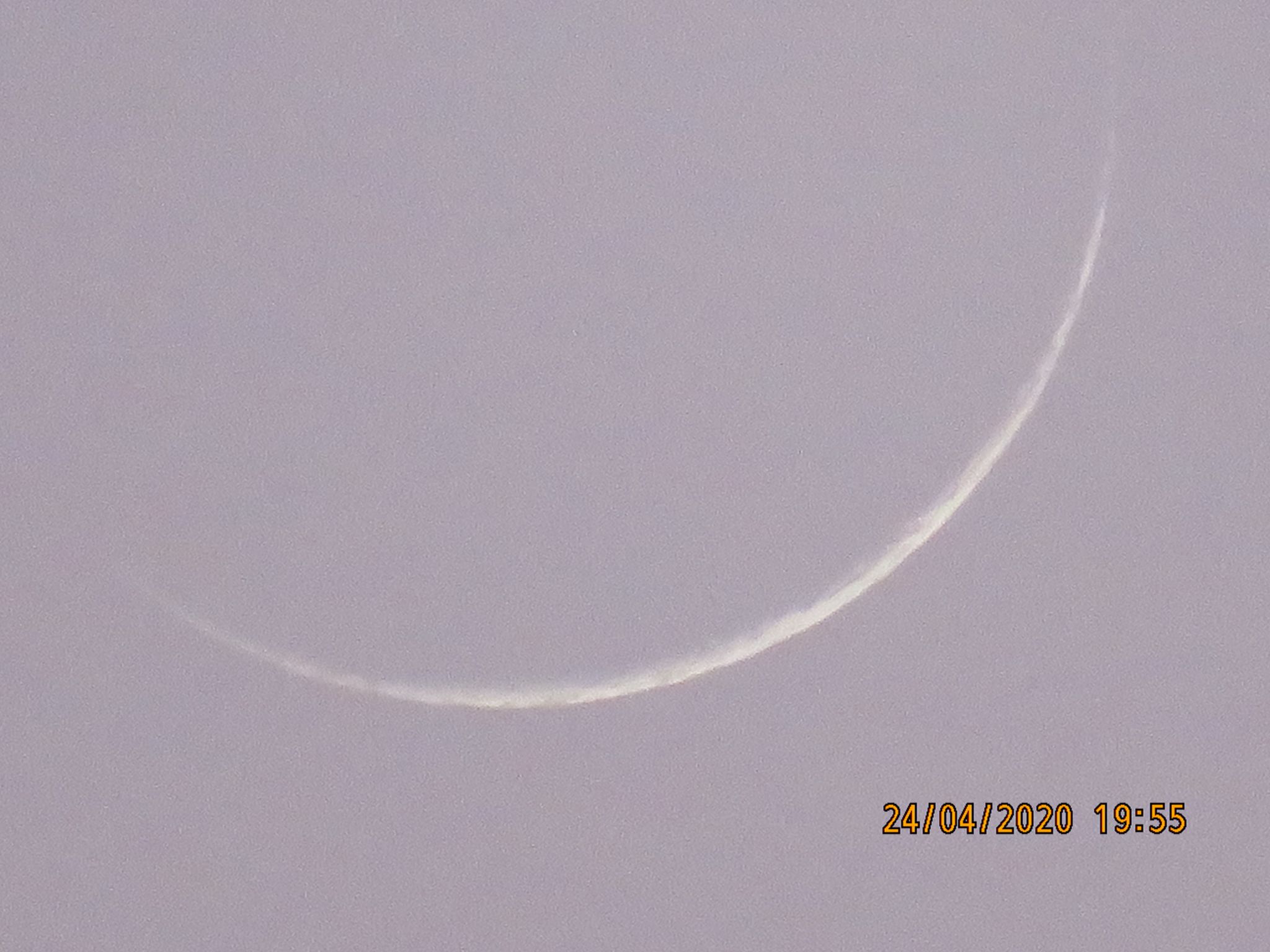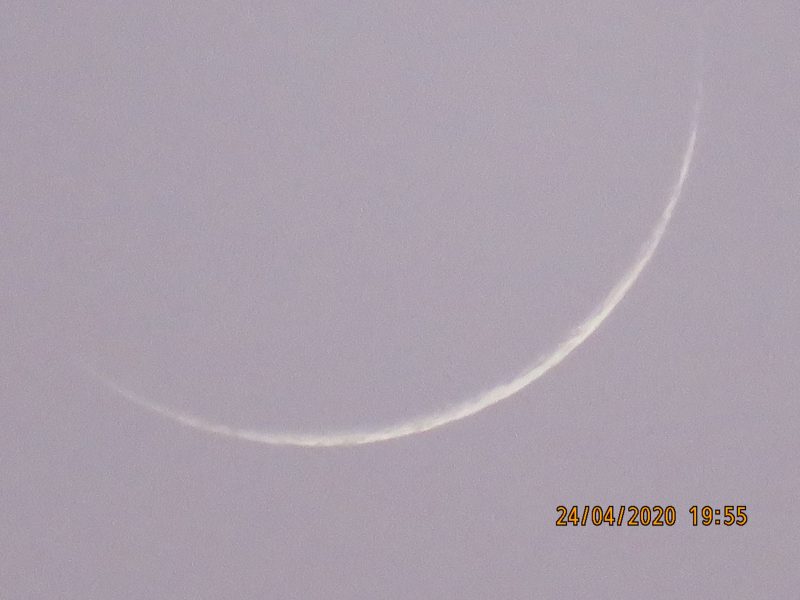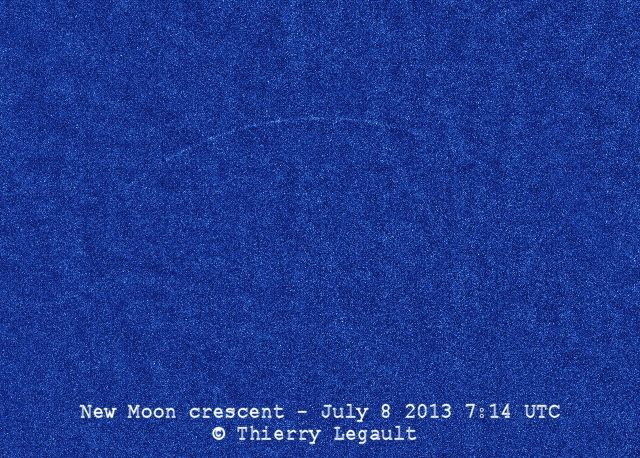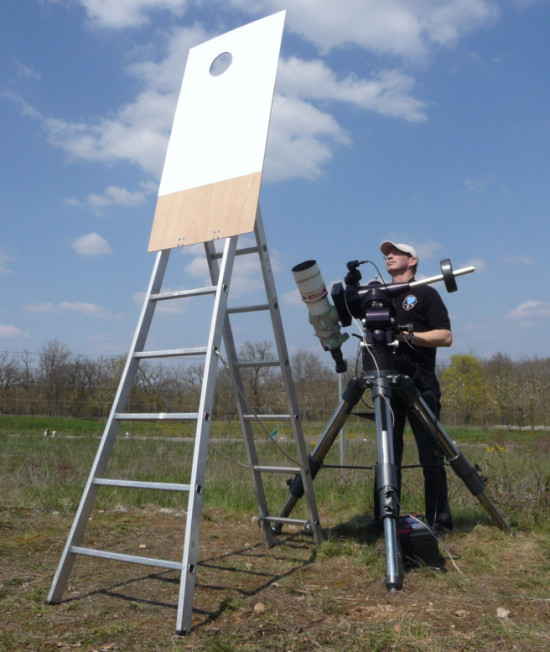

View at EarthSky Community Photos. | Mohamed Mohamed of Tripoli, Libya, captured a young moon on April 24, 2020. Thank you, Mohamed!
It’s long been a sport among amateur astronomers to spot the youngest possible moons with optical aid, or with the eye alone. A new moon is more or less between the Earth and sun, crossing the sky with the sun during the day. A young moon is a moon some hours or days after the exact instant of new moon. From the Americas, it might be possible to catch the skinniest of young moons – fresh from the June 21, 2020, annular solar eclipse – at dusk on June 21. To see it, you will need a very clear western horizon, immediately after sunset. You’ll want to bring along your binoculars to sweep for the frail crescent that’ll be only about 0.5% illuminated in sunshine.
Typically, you won’t see a moon less than about 24 hours on either side of new moon. But, if you try, you can sometimes see the moon with the eye alone much closer to the new phase. June 2020’s new moon falls at 06:41 UTC on June 21. At sunset in the central U.S. on that day – say, in Wichita, Kansas, which uses Central Daylight Time – the moon will be about 19 hours old at sunset. As you move westward at mid-northern latitudes in North America into Mountain Daylight Time, the moon will be about 20 hours old at sunset. It’ll be about 21 hours old at sunset for those on the North American west coast, and so on – older and older – as you continue moving west toward islands in Pacific.
So you might see that – in terms of your chances of catching the very young moon – the farther west you are in North America (or on a Pacific island), the better.
Young moons are located some distance east of the sun on the sky’s dome (because the moon always moves eastward in orbit). Young moons appear to our eye as exceedingly slim crescents, likely illuminated by earthshine, seen low in the western sky for a brief interval after sunset.
So watch for the June 21, 2020 young moon! You might catch it.
What is the youngest moon you can see? More about that below.

View larger. | We received the photo above from Sarah Nordin. It’s a very unusual photo of an extremely young moon – caught only 15 hours, 19 minutes after the instant of new moon – in daylight, on November 8, 2018. Be sure to click in and view it larger to appreciate it. Sarah caught this moon at Telok Kemang Observatory in Port Dickson, Malaysia. Camera: Nikon D300s. Telescope: Takahashi TOA-150. Camera setting: ISO160_1/640s_RAW file. Congratulations, Sarah!
What’s the youngest moon it’s possible to see?
As we mentioned, it’s rare to see a moon within about 24 hours of the new phase. But if you try you can see a moon much closer to new. And, if you use optical aid, it turns out you can see the moon all the way until the moment of new moon.
On July 8, 2013, a new record was set for the youngest moon ever photographed (see photos on this page). Thierry Legault – shooting from in Elancourt, France (a suburb of Paris) – captured the July 2013 moon at the precise instant it was new, or most nearly between the Earth and sun for this lunar orbit. Legault’s image (below) shows the thinnest of lunar crescents, in full daylight (naturally, since a new moon is always near the sun in the sky), at 07:14 UTC on July 8, 2013. Legault said on his website:
It is the youngest possible crescent, the age of the moon at this instant being exactly zero. Celestial north is up in the image, as well as the sun. The irregularities and discontinuities are caused by the relief at the edge of the lunar disk (mountains, craters).

Youngest lunar crescent, with the moon’s age being exactly zero when this photo was taken — at the precise moment of the new moon – at 07:14 UTC on July 8, 2013. Image by Thierry Legault. Visit his website. Used with permission.

Here is Thierry Legault and his setup for capturing the youngest possible moon. See more photos and read more on his website.
What’s the youngest moon you’re likely to see with your eye alone?
How young a moon you can expect to see with your eye depends on the time of year and on sky conditions. It’s possible to see the youngest moons – the thinnest crescents, nearest the sunset – around the spring equinox. That would be March for the Northern Hemisphere or September for the Southern Hemisphere.
When Legault captured the image above, the sun and moon were separated only 4.4 degrees – about 9 solar diameters – on the sky’s dome. It is extremely difficult, and risky, to try to capture the moon at such a time. Not only is the sight of our companion world drowned in bright sunlight, but there is also a risk of unintentionally glimpsing the sun and thereby damaging your eyesight.
That’s why Legault used a special photographic setup to capture this youngest possible moon. He wrote:
In order to reduce the glare, the images have been taken in close infrared and a pierced screen, placed just in front of the telescope, prevents the sunlight from entering directly in the telescope.
A longstanding, though somewhat doubtful record for youngest moon seen with the eye was held by two British housemaids, said to have seen the moon 14 3/4 hours after new moon in the year 1916.
A more reliable record was achieved by Stephen James O’Meara in May 1990; he saw the young crescent with the unaided eye 15 hours and 32 minutes after new moon. The record for youngest moon spotted with the eye using an optical aid passed to Mohsen Mirsaeed in 2002, who saw the moon 11 hours and 40 minutes after new moon.
Wow!
And, of course, optical aid enhances your young moon possibilities even more.
But Legault’s photograph at the instant of new moon? That record can only be duplicated, not surpassed.

View larger. | Very young moon – similar to one your’re likely to catch using just your eyes – captured by EarthSky Facebook friend Susan Gies Jensen on February 10, 2013, in Odessa, Washington. Note the bright twilight behind the moon. Beautiful job, Susan! Thank you.
Bottom line: What’s the youngest moon it’s possible to see? As astrophotographer Thierry Legault proved in 2013, it’s possible to capture a moon at the instant the moon is new. How about young moon sightings with the eye alone? The youngest observed moons, and a young moon possibility on June 21, 2020, here.
Click here to check out Thierry Legault’s book on astrophotography.
Source:
https://earthsky.org/astronomy-essentials/young-moon-visibility